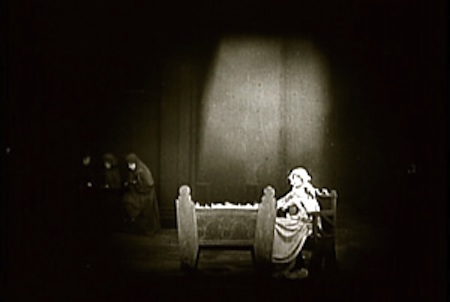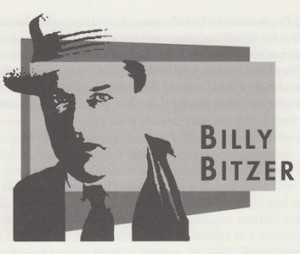Born: April 21, 1872, Roxbury, MA
Died: April 29, 1944, Hollywood, CA
The greatest inventor among cameramen was perhaps Billy Bitzer.
—Kenneth McGowan
In the dawn of motion pictures, there were no directors, only camera operators. And the quintessential pioneer among fledgling cameramen was Johann Gottlob Wilhelm Bitzer, better known as “Billy.” Though he joined the Biograph company as an electrician in 1901, Bitzer swiftly advanced to cameraman and served his apprenticeship by photographing train arrivals, piano recitals and boat christenings for the sputtering nickelodeons at the turn of the century. It was Billy Bitzer who explored the possibilities of the camera, and his timeless discoveries are the fundamental building blocks of filmmaking, evident in every movie made today.
The Film 100
1. W.K. Laurie Dickson
2 Edwin S. Porter
3. Charlie Chaplin
4. Mary Pickford
5. Orson Welles
6. Alfred Hitchcock
7. Walt Disney
8. D.W. Griffith
9. Will Hays
10 Thomas Edison
11. John Wayne
12. J.R. Bray
13. Billy Bitzer
14. Jesse Lasky
15. George Eastman
16. Sergei Eisenstein
17. André Bazin
18. Irving Thalberg
19. Thomas Ince
20. Marlon Brando
21. Louis B. Mayer
22. Greta Garbo
23. Robert Flaherty
24. Lon Chaney
25. Anita Loos
26. George Méliès
27. Adolph Zukor
28. John Gilbert
29. Max Fleischer
30. John Ford
31. William Fox
32. George Lucas
33. Linwood Gale Dunn
34. Eadweard Muybridge
35. Katharine Hepburn
36. Winsor McCay
37. Stanley Kubrick
38. Buster Keaton
39. James Agee
40. Fritz Lang
41. Marcus Loew
42. Cedric Gibbons
43. James Cagney
44. Ben Hecht
45. Ingmar Bergman
46. Humphrey Bogart
47. Leon Schlesinger
48. Louella Parsons
49. Roger Corman
50. Edith Head
51. Bernard Herrmann
52. Gary Cooper
53. Mike Todd
54. Ernst Lubitsch
55. Sidney Poitier
56. Saul Bass
57. Billy Wilder
58. Bette Davis
59. Erich von Stroheim
60. Max Factor
61. Auguste and Louis Lumière
62. Woody Allen
63. Clark Gable
64. David O. Selznick
65. Gregg Toland
66. Lillian Gish
67. William Cameron Menzies
68. Lucille Ball
69. Samuel Rothafel
70. Akira Kurosawa
71. Marilyn Monroe
72. Vittorio De Sica
73. Natalie Kalmus
74. Gene Siskel and Roger Ebert
75. Willis O’Brien
76. Shirley Temple
77. Yakima Canutt
78. Sam Peckinpah
79. Jackie Coogan
80. Federico Fellini
81. Leni Riefenstahl
82. Steven Spielberg
83. Sam Warner
84. Jean-Luc Godard
85. Robert De Niro
86. Fred Astaire
87. Francis Ford Coppola
88. Ted Turner
89. Clint Eastwood
90. Dalton Trumbo
91. Dennis Hopper
92. Richard Hollingshead
93. Melvin Van Peebles
94. John Chambers
95. Mack Sennett
96. Martin Scorsese
97. Karl Struss
98. Busby Berkeley
99. John Hubley
100. John Cassavetes
The turn-of-the-century cameraman was a lone operator, an entire production crew on foot. Each day, Bitzer would fold up his tripod and hoist the camera over his shoulder, then set out onto the streets of New York to capture a short film. He had total control of filming: loading the reels, choosing the setups, hand-cranking the footage and controlling the exposure. When the demands of his assignment increased, Bitzer packed up a horse-drawn wagon with additional cameras and drove around with assistants to faraway locations. He captured many of the day’s most important news and sporting events in a journalistic fashion. A highlight of Bitzer’s days as a newsreel cameraman was his filming of William McKinley’s presidential nomination, a reel that became the first Biograph film presentation. As the first cameraman to record moving pictures in battle, Bitzer covered the Spanish-American War for the Heart newspaper chain.
Bitzer was behind the camera on nearly all of Biograph’s landmark films, honing his craft and toying with film exposures. In his years of filming news reports, Bitzer had learned to introduce a “fade to blackout” into shots by placing an opaque piece of black paper over the camera lens and letting the reel wind for a few feet, allowing less light into the exposure. This gave the final film a graceful break between subjects. By doing this several times a day, Bitzer became quite skillful at fading in and out of shots, sometimes winding the film canister back a few feet to overlap exposures.
When Biograph yanked him off his street duties and assigned him to watch over a talented new director, it was the beginning of a historic collaboration that would spark Bitzer’s inventive mind and set him free to experiment. He would become D.W. Griffith’s personal cinematographer, spending the next sixteen years working side by side with the director on close to four hundred film projects. He personally cranked the camera on nearly all of the Griffith classics—prominent among them, The Birth of a Nation (1915), Intolerance (1916) and Way Down East (1920).
One lucky consequence of this partnership was the application of Bitzer’s streetwise camera effects on Griffith’s straightforward narrative films. The fades and superimposed images began to shape the narrative structure, acting as smooth transitions and suggesting time lapses between scenes. Suddenly, the Griffith films took on a sophistication unseen in any other director’s. Bitzer would vontinue to create these in-the-camera effects, which never required the help of editing. He introduced the famous “iris” fade effect, where the movie frame closes in from all sides to encircle a telling detail, prop or facial expression. He developed the diffusion screen for lenses to produce a soft-focus look, used in later years to hide the wrinkles of aging stars. He would eventually master other optical tricks, including the freeze frame, which is found decades later in François Truffaut’s The 400 Blows (1959), Martin Scorsese’s Goodfellas (1990) and scores of other films.
Two other areas of expertise made Bitzer the perfect cameraman to capture Griffith’s classics: he was as adept at filming close-ups as at taking long shots. The famous spectacle Intolerance (1916) gets most of its attention because of its huge sets, but Bitzer was responsible for capturing them on film. Master of the long shot, he often strapped the camera to the front of a car and rode, straddling the hood, through the gargantuan Babylon.
It can fairly be claimed that Billy Bitzer put a roof over Hollywood’s head. In the earliest days of silent pictures, all films were shot outside; if an interior shot was required, three walls were haphazardly erected in a clearing. Pioneering studios were built with removable ceilings that rolled away to expose the set to daylight. But Bitzer was the first to use artificial light, photographing completely indoors without the benefit of sunlight, as early as 1909. This took films off the streets and into enclosed studios where cast and crew were sheltered from the elements.
After years of developing a sense of the proper film exposures required in natural light, Bitzer had to learn to adjust indoor lighting to meet the needs of the film stock. In this way, he became the first true cinematographer. He also instituted the classic three-point lighting setup that most films since have used without variation: a key light on the actor, a fill light on the set and a backlight to help separate the actor from the background elements. Backlighting instantly became an important cinematic concept, and Bitzer developed the first foil-covered reflectors for directing backlight into strategic positions. These findings were both critical to controlling the look of a film and to creating the appropriate mood. He was also the first to play with special lighting effects; he would cast flickers of light onto the set to give the illusion of candlelight, firelight or morning sun. Among the hundreds of cameramen who contributed to the earliest discoveries of motion pictures, none came close to matching the numerous advancements that Bitzer stumbled on through his endless tinkering.
His trove of tricks and techniques usually brought more fame and credit to his directors and colleagues than to himself. Bitzer would go on to turn several of his assistants into fine cameramen and directors, notably Karl Brown, Erich von Stroheim and Tod Browning. As the ace cameraman of the industry, he helped form the photographers’ unions both on the East Coast and in Hollywood. Until his death in 1944, he spent his retirement restoring some of the world’s earliest film recordings under the care of New York’s Museum of Modern Art, many of which he had originally filmed himself. Shortly after his autobiography was published posthumously in 1973, the Billy Bitzer Awards were established by the International Photographers Guild in New York to honor those who have made a lasting contribution to the film industry.
For more than one hundred years, cinema has benefited from the seminal camera work of Billy Bitzer. Although the moviegoing public revered the talented Griffith for many of Bitzer’s innovations, the close-knit circles of the industry had only the highest respect for the contributions of this legendary cameraman.
To read all the republished articles from ‘The Film 100,’ go to Reintroducing the Film 100 here on Keyframe.





